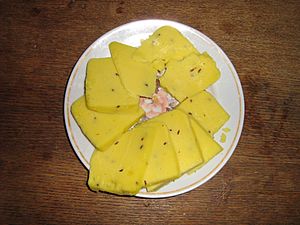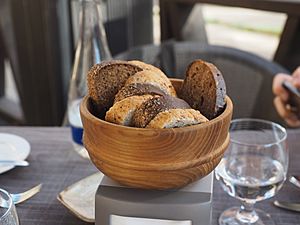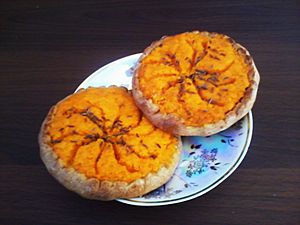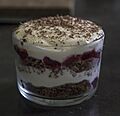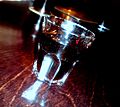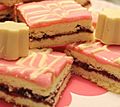Latvian cuisine facts for kids
Latvian food is mostly made from things grown on farms, and meat is a big part of most main meals. Because Latvia is on the eastern coast of the Baltic Sea, fish is also eaten a lot.
Latvian cooking has been shaped by other countries around the Baltic Sea. Many ingredients come from local farms, like potatoes, wheat, barley, cabbage, onions, eggs, and pork. Latvia has four clear seasons, so the food changes with the time of year, using fresh products from each season. Latvian food is often quite rich and doesn't use many spices.
Contents
Daily Meals in Latvia
Most Latvians today eat three meals a day. Breakfast is usually light, like sandwiches or an omelette, with a drink such as milk. Lunch is eaten from noon to 3 p.m. and is often the biggest meal. It can include many different foods, sometimes even soup as a first course and a dessert. Supper is the last meal of the day, and some people choose to eat another large meal then. It's also common now to eat ready-made or frozen meals.
Popular Latvian Dishes
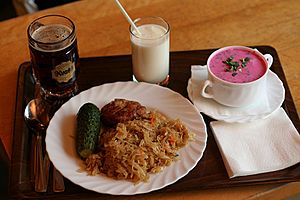
Latvian food is typical for the Baltic region and northern countries. It uses a lot of butter and fat but not many spices, except for black pepper, dill, or seeds like caraway. Latvian cooking started from what farmers ate and uses crops that grow well in Latvia's cool, coastal weather. Rye or wheat, oats, peas, beets, cabbage, pork, and potatoes are main foods.
Latvian cuisine has many kinds of bread and milk products, which are very important. Meat is in most main dishes, but fish is also eaten often, especially near the Baltic Sea coast. Both meat and fish are also smoked.
Many common dishes in Latvia today came from other countries, often because of their history. Popular dishes from Soviet cuisine include pelmeni (small dumplings) with sour cream, borsch (beetroot soup), stroganoff (meat in a creamy sauce), dressed herring (herring salad), shashlik (grilled meat skewers), rasol (potato salad), plov (rice dish), kefir (fermented milk drink), kvass (fermented bread drink), and solyanka (thick, sour soup).
The most popular alcoholic drink is beer. A special national drink is Riga Black Balsam, a dark, strong herbal liqueur.
Milk Products
Latvia has more kinds of milk products than many Western countries. You can find Cottage cheese (biezpiens), sour cream (skābais krējums), soured milk (rūgušpiens), and many types of fresh and dried cheeses. Kefir, soured milk, and other fermented milk drinks are often enjoyed with hot meals.
Cottage cheese is often mixed with sour cream and eaten for breakfast. It's also added to salads and used in cakes and desserts, like the curd snack (biezpiena sieriņš). In 2012, the Kārums curd snack was voted the most popular product by Latvian shoppers. For lunch, cottage cheese is traditionally eaten with boiled potatoes, lightly salted herring, spring onions, and sour cream.
Since the early 1900s, a special kind of butter called Rucava white butter (Rucavas baltais sviests) has been made in Rucava. In 2018, it received a special protection status in the European Union. Butter can also be mixed with roasted and ground hemp seeds and salt to make hemp butter (kaņepju sviests), which is usually eaten with rye bread.
Cheese often has seeds, nuts, dried fruits, clover, or mixed dried herbs added to it. It can also be smoked or aged in oil. Fresh cheese is served with garlic or herbs. A traditional Latvian cheese is Jāņi cheese, made and served during the summer festival Jāņi. It is seen as a symbol of Latvian culture.
Soups
Soups are commonly made with vegetables and broth or milk. Cold soup (aukstā zupa), fish soup (zivju zupa), sorrel soup (skābeņu zupa), and mushroom soup (sēņu zupa) are also popular. A traditional Latvian dessert is rye bread soup (maizes zupa), made from rye bread, whipped cream, dried fruit, and cranberries.
Cold soup is usually made in the spring. It contains kefir or soured milk, boiled beets, chopped radish, fresh cucumbers, boiled eggs, and different green herbs.
Bread
Rye bread (rudzu maize) has been a main food in Latvia for hundreds of years and is part of the Latvian Culture Canon. This bread is similar to a Russian or German black bread. It is made from coarse rye flour, malt, and caraway seeds, and traditionally baked in a wood-fired oven. Another popular bread is sweet and sour bread (saldskābmaize), made from finely ground rye flour and caraway seeds. Fried rye bread with garlic (ķiploku grauzdiņi) and mayonnaise is often served as a starter in restaurants and bars. White bread (baltmaize) used to be a special treat and was only eaten on holidays.
Pastries
A popular pastry is the speķa pīrāgi. These are wheat or rye flour buns filled with finely cut streaky bacon and onions. Sometimes caraway seeds are added to the dough. Speķa pīrāgi are common pastries for Ziemassvētki (Christmas) and Jāņi (Midsummer). Kliņģeris is a sweet pretzel-shaped bread often served as a dessert on special days, like a name day. Sklandrausis is a traditional Latvian dish with Livonian roots. It's a sweet pie made from rye dough, filled with potato and carrot paste, and seasoned with caraway. In 2013, sklandrausis received a special "Traditional Speciality Guaranteed" status from the European Commission.
Drinks
Fresh birch sap is a very popular drink in spring. People also like to ferment birch sap by adding raisins, blackcurrant twigs, or lemon peels. Some companies sell sparkling fermented birch sap all year.
Before the 13th century, ancient Latvians brewed beer (alus), mead (miestiņš), and honey beer (medalus) for celebrations and daily use. After the Baltic Crusades, local beer brewing changed due to new techniques from Western Europe. For example, many different herbs were used before, but then hops became popular for preserving and flavoring. A craft brewery called Labietis continues the old tradition, using various herbs, flowers, berries, and spices in their beers.
With new types of grapes that can grow in colder climates, winemaking has become more common in Latvia. Also, raspberry, black currant, and other fruit and berry wines are made, as well as ciders. The Wine Hill of Sabile was once listed in the Guinness World Records as the most northern open-air vineyard in the world. Since 1999, the town also holds an annual wine festival.
Mushrooms
Latvia has old traditions of eating wild mushrooms. Picking mushrooms in the forest is very popular in autumn. Both modern and traditional ways of cooking mushrooms are common. There are about 4,100 types of mushrooms in Latvia, and about a quarter of them are safe to eat. The most popular edible ones are various Boletus and Cantharellus mushrooms. People often make a mushroom sauce from mushrooms, onions, garlic, sweet or sour cream, and sometimes bacon. This sauce is usually eaten with boiled potatoes and lightly salted cucumbers.
Images for kids
-
Head cheese (galerts)
-
Layered rye bread (rupjmaizes kārtojums)
-
Redcurrant semolina mousse (jāņogu debesmanna)
-
Curd snack (biezpiena sieriņš)
-
Gingerbreads from Latvia
See also
 In Spanish: Gastronomía de Letonia para niños
In Spanish: Gastronomía de Letonia para niños


